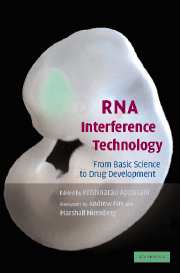Book contents
- Frontmatter
- Contents
- Foreword by Andrew Fire
- Foreword by Marshall Nirenberg
- List of Contributors
- Introduction
- Section one Basic RNAi, siRNA, microRNAs and gene-silencing mechanisms
- Section two Design, synthesis of siRNAs
- Section three Vector development and in vivo, in vitro and in ovo delivery methods
- Section four Gene silencing in model organisms
- 17 Practical applications of RNAi in C. elegans
- 18 Inducible RNAi as a forward genetic tool in Trypanosoma brucei
- 19 RNA-mediated gene silencing in fission yeast
- 20 RNA silencing in filamentous fungi: Mucor circinelloides as a model organism
- 21 RNAi and gene silencing phenomena mediated by viral suppressors in plants
- Section five Drug target validation
- Section six Therapeutic and drug development
- Section seven High-throughput genome-wide RNAi analysis
- Index
- Plate section
- References
21 - RNAi and gene silencing phenomena mediated by viral suppressors in plants
Published online by Cambridge University Press: 31 July 2009
- Frontmatter
- Contents
- Foreword by Andrew Fire
- Foreword by Marshall Nirenberg
- List of Contributors
- Introduction
- Section one Basic RNAi, siRNA, microRNAs and gene-silencing mechanisms
- Section two Design, synthesis of siRNAs
- Section three Vector development and in vivo, in vitro and in ovo delivery methods
- Section four Gene silencing in model organisms
- 17 Practical applications of RNAi in C. elegans
- 18 Inducible RNAi as a forward genetic tool in Trypanosoma brucei
- 19 RNA-mediated gene silencing in fission yeast
- 20 RNA silencing in filamentous fungi: Mucor circinelloides as a model organism
- 21 RNAi and gene silencing phenomena mediated by viral suppressors in plants
- Section five Drug target validation
- Section six Therapeutic and drug development
- Section seven High-throughput genome-wide RNAi analysis
- Index
- Plate section
- References
Summary
Introduction
Posttranscriptional gene silencing (PTGS) is a natural, universal mechanism that degrades both cellular and viral mRNA in a homology-dependant manner in diverse eukaryotes, and has now become a major area of research and development in both plants and animals. It was first discovered in plants (Napoli et al., 1990), while a mechanistically similar phenomenon is known to occur in a wide range of organisms, including Caenorhabditis elegans, Drosophila melanogaster and mammals termed RNA-interference (RNAi) (Fire et al., 1998, Hammond et al., 2000) and in Neurospora crassa termed quelling (Cogoni and Macino, 1997). Transgenes and viruses can induce PTGS in plants, and it is now recognized as a natural defense mechanism against virus infection (Hamilton and Baulcombe, 1999). Recent studies at the molecular level revealed that all of these phenomena are considered as manifestations of a general RNA-targeting pathway (Vance and Vaucheret, 2001). The mechanism by which a virus infection triggers PTGS in plants is not fully understood, but it is evident that dsRNA is a strong inducer of PTGS (Waterhouse et al., 2001). Such dsRNA molecules are produced during RNA virus replication using their own RNA-dependent RNA polymerase (RdRP), or alternatively host RdRPs convert any “aberrant” ssRNA in the cell, from viral origin or cell origin, into dsRNA (Dalmay et al., 2000; Ahlquist, 2002). The biology and biochemistry of RNAi was discussed in detail in Section I of this book.
- Type
- Chapter
- Information
- RNA Interference TechnologyFrom Basic Science to Drug Development, pp. 280 - 300Publisher: Cambridge University PressPrint publication year: 2005
References
- 1
- Cited by



